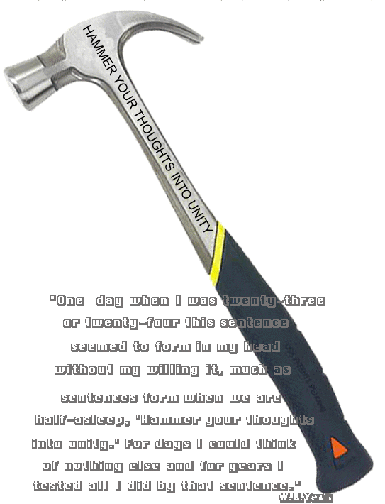
"Only connect! . . .Live in fragments no longer.” E. M. Forster, Howards End (1910), ch. 22

‘One day when I was twenty-three or twenty-four this sentence seemed to form in my head, without my willing it, much as sentences form when we are half-asleep, ‘Hammer your thoughts into unity’. For days I could think of nothing else and for years I tested all I did by that sentence [...]” William Butler Yeats (cited in Frank Tuohy, Yeats, 1976, p.51 )
E 320M, Nineteenth-century Literature, Architecture, and Art -- Spring 06
2-3:30 PAR 104
Computer-Assisted Instruction
Substantial Writing Component
Instructor: Bump; <mailto:bump@mail.utexas.edu>; Office: PAR 132 Office phone: 471-8747
office hours: Tu. Th.9:45-10:45, 3:30-4 and by appointment.
“Larger universities must find ways to create a sense of place and to help students develop small communities within the larger whole.” Carnegie’s Reinventing Undergraduate Education: A Blueprint for America’s Research Universities (http://notes.cc.sunysb.edu/Pres/boyer.nsf)
Our primary goal is to develop "a sense of place,” an awareness of this campus as your second home, your Alma Mater (nurturing mother). One of our mottos will be “think outside the box.” Hence, some class meetings will be outside the classroom box, devoted to drawing and writing about nature, buildings, and works of art, at campus buildings and nature sites. In other words, we will become readers of all the texts the campus and the world present to us, especially those in nature and in architecture and their representation in literature, science, sculpture, and painting. The printed texts will include Wordsworth, Dickens, Darwin, Tennyson, Browning, Arnold, Hopkins, Ruskin, Pater, Newman, Adams, Morris, the Rossettis, Pugin, Eiseley, Forster, Dobie, Jones, Taniguchi, the Bible, and others.
We will write answers to basic questions about ourselves and our environments, such as “what is this”? “where did it come from?” and “why is it here?” We will discover that objects around us are palimpsests with layers of meaning we can trace through time back to various eras and places. For example, the carved griffins on the mantle in the Littlefield House will lead us, via the internet, to medieval cathedrals, and what Adams and Ruskin wrote about them. Students will do presentations on murals and paintings.
One of our research projects will revolve around the concept of "Truth to Nature" and these two debate topics:
[1] Resolved: Evolutionary theory and a spiritual approach to nature are incompatible.
[2] Resolved: The best style for campus architecture, sculpture, painting, etc. is a modernist style looking to the future.
Grades: The final grade (1000 points) will be determined as follows: 250 by a formal argumentation project on the debate topics above (150 for the first draft, 100 for the revision), 400 by informal writing assignments, 100 by the final portfolio of all of the student’s work, and 250 by class participation. Grades are not negotiable: students will receive exactly the grade recorded in the online gradebook, even if it is one point short of the next higher grade. 900 points are required for an A-; 800 for a B-; 700 for a C-; 600 for a D-.
Projects. Initial comments on the projects will be made by the other students in Blackboard Discussion format, with the instructor then focusing on polishing subsequent hard copies for word choice, punctuation, etc. Rewriting and preparing almost perfect final drafts will be stressed. Procrastination will be heavily penalized.
Informal Writing includes contributions to Discussion Boards, in-class exercises, and your individual learning record (LR), encouraging students to set their own goals and become aware of their learning styles and obstacles. The LR concludes with short interpretive essays written at midterm and semester's end.
Class participation consists of showing up in class on time with the right books, having read the material assigned for that day, and being prepared to talk about it. It is important to share in class: one of the goals of the course is better spoken as well as written communication, and listening when others are speaking. Showing up late or not paying attention is not acceptable.
Pedagogy: Inspired by a famous Freshman English course at Amherst College, the method of this course is discovery learning, also known as active learning, or learning by doing. Hence at times there may be fewer instructions than what students may be used to from other courses. In other words, students should be prepared to think for themselves. This can be frustrating for some, especially those who want a detailed formula that will guarantee them a good grade. Instead students will be encouraged to be creative and speak and write about what is important to them. More features of my teaching philosophy can be seen at http://www.la.utexas.edu/users/bump
Texts: the Writing Skills Handbook by Charles Bazerman, and a collection of xeroxed materials to be purchased from Jenn's, 2000 Guadelupe (basement of the church of scientology at 22nd), 473-8669. It will cost about $55; Jenn’s takes major credit cards, of course. If you don’t get there within the first few days you might want to call ahead to make sure they have a copy reserved for you (sometimes they do not print them all right away).
Fees: As much as $7.50 may be required for the Story of Texas museum.
